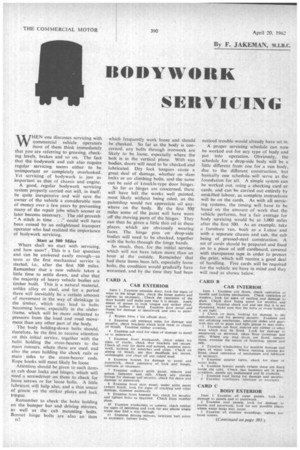BODYWORK SERVICING
Page 52

If you've noticed an error in this article please click here to report it so we can fix it.
By F. JAKEMAN,
WHEN one discusses servicing with commercial vehicle operators most of them think immediately that you are referring to greasing, checking levels, brakes and so on. The fact that the bodywork and cab also require regular servicing seems either to be unimportant or completely overlooked. Yet servicing of bodywork is just as important as that of chassis and engine.
A good, regular bodywork servicing system properly carried out will, in itself, be quite inexpensive and will save the owner of the vehicle a considerable sum of money over a few years by preventing many of the repair jobs which sooner or later become necessary. The old proverb "A stitch in time . . ." could well have been coined by an enlightened transport operator who had realized the importance of bodywork servicing.
Start at 500 Miles
Where shall we start with servicing, and how soon? i This is a fair question and can be answered easily enough—as soon as the first mechanical service is started, i.e., after the first 500 miles. Remember that a new vehicle takes a little time to settle down, and also that the majority of heavy vehicle bodies are timber built. This is a natural material, unlike alloy or steel, and for a period there will inevitably be a certain amount of movement in the way of shrinkage in the timber, which may lead to bolts becoming loose, especially in the underframe, which will be more subjected to pressure from the load and road movement than any other part of the body.
The body holding-down bolts should, therefore, be the first to receive attention on this initial service, together with the bolts holding the cross-bearers to the main runners. where these are used. and also the ones holding the chock rails or main sides to the cross-hearer ends. Rope hooks will most likely be loose Attention should be given to such items as cab door locks and hinges, which will need a screwdriver on them to check for loose screws or for loose bolts. A little lubricant will help also, and a thin smear of grease on the striker plates and lock tongue.
Remember to check the bolts holding on the bumper bar and driving mirrors, as well as the cab mounting bolts. Bonnet hinge bolts are also an item D2 . which frequently work loose and should be checked. So far as the body is concerned, any bolts through ironwork are likely to be loose, especially where the bolt is in the vertical plane. With van bodies, doors will need to be checked and lubricated. Dry lock tongues cause a great deal of damage. whether on slam locks or on climbing bolts, and the same can be said of knuckle-type door hinges.
So far as hinges are concerned, these will have left the works well painted, most likely without being oiled, as the paintshap would not appreciate oil anywhere on the body. By the first 500' miles some of the paint will have worn off the moving parts of the hinges. They can then be given a little thin oil in these places. which are obviously wearing faces. The hinge pins on drop-side bodies will need to be checked, together with the bolts through the hinge bands.
So much, then, for the initial service, which will not have taken more than an hour at the outside. Remember that had these items been left, especially loose bolts. the condition would gradually have worsened, and by the time they had been noticed trouble would already have set in.
A proper servicing schedule can now be worked out for any type of body and put into operation. Obviously, the schedule for a drop-side body will be a little different from one for a van body, due to the different construction, but basically one schedule will serve as the foundation for all. A simple system can be worked out. using a checking card or cards. and can -be carried out entirely by unskilled labour, as complete instructions will be on the cards. As with all servicing systems. the timing will have to be based on the amount of work that the vehicle performs. but a fair average for body servicing would be at 3,000 miles after the first 500. As an example, take a furniture van, built as a Luton and with a separate chassis and cab. the cab being of pressed-steel construction. A set of cards should be prepared and fixed on to a piece of stiff cardboard, covered with transparent tape in order to protect the print, which will receive a good deal of handling. Five cards will be required for the vehicle we have in mind and they will read as shown below.
















































































































